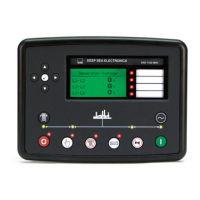–The governor or motorised potentiometer is controlled
by the DSE modules’ own internal relays.
NOTE: It will be necessary to configure two of the module
relays to provide the required ‘Speed raise’ and ‘Speed Lower’
signals.
Internal Analogue module – This is used to provide a DC voltage
output to interface with many engine speed governors remote speed
adjust or load sharing controller inputs.
Governor Output Reversed
This allows the module to interface with a greater diversity of
governors.
= Lower voltage equates to lower speed.
= Lower voltage equates to higher speed.
synchroniser during the period that the set is running on load.
Adjust to Centre Point – Whenever generators are required to run in
parallel, then active load sharing is recommended. However, this may
not be essential when the accuracy of the load sharing is not critical and
is only required for short periods. In this case ‘droop’ governors must be
used in conjunction with the ‘synchronising reset option – reset to datum
on load’ feature. This works on the principal that the governed frequency
of each generator for any given load will be the same when at its datum
setting. This approach is generally unsuitable for mains connected
systems but will provide rudimentary load sharing between two or more
generators.
Adjust to Nominal – When on load as a single set (but not in parallel)
the load sharing module will effect changes to the governor and to keep
the system frequency at nominal levels. These levels are user
adjustable on the ‘generator’ tab accessible via Config Suite PC
software.
This is used to ensure the nominal frequency of the system is
maintained even if droop is configured.
None – Adjustment will not take place; the speed will remain at current
levels.
When in parallel with other sets, the load share controller will
automatically keep the system frequency at nominal levels regardless of
the selection of this parameter.

